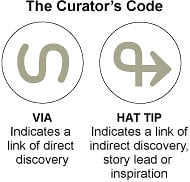With access to written work at the fingertips of millions of people online, instances of plagiarism have dramatically risen in recent years. Many bloggers and social media voices are unaware of how (or why) to give proper attribution to the original author or source. Ideas on how to do so have been considered over the years -- e.g. inline source links -- for how to ensure that authors receive credit for their work, but none have been completely effective in citing the original source.
I n an effort to change this, Mary Popova from Brain Pickings just launched the Curator’s Code of Ethics. Curatorscode.org proposes a code of conduct for citing sources on the web -- using “via” or “hat tip” characters. The ᔥ symbol for “via” indicates a link of direct discovery. The ↬ symbol for “hat tip” indicates a link of indirect discovery, story lead, or inspiration. Popova suggests that this is a way to standardize attribution on the web, similar to the unicode characters ™ for “trademark” and © for “copyright.”
n an effort to change this, Mary Popova from Brain Pickings just launched the Curator’s Code of Ethics. Curatorscode.org proposes a code of conduct for citing sources on the web -- using “via” or “hat tip” characters. The ᔥ symbol for “via” indicates a link of direct discovery. The ↬ symbol for “hat tip” indicates a link of indirect discovery, story lead, or inspiration. Popova suggests that this is a way to standardize attribution on the web, similar to the unicode characters ™ for “trademark” and © for “copyright.”
In a blog post, Marco Arment of Marco.org criticizes Popova’s efforts, claiming that no one will use them. He writes:
“But the inscrutability of these little symbols is irrelevant, because most writers aren’t going to use them. The problems with online attribution aren’t due to a lack of syntax: they’re due to the economics and realities of online publishing....The proper place for ethics and codes is in ensuring that a reasonable number of people go to the source instead of just reading your rehash. Codifying “via” links with confusing symbols is solving the wrong problem.”
According to The New York Times, other groups, including the Council on Ethical Blogging and Aggregation, are also thinking about ways to bring order to the tornado of content hitting the web every day. Whether there will be a solution for taming the chaos is unclear. Perhaps the largest impact of this effort is to raise awareness of the issue and inform the masses about acceptable practices for writing on the web.
References
Popova, Maria. “Introducing The Curator’s Code: A Standard for Honoring Attribution of Discovery Across the Web.” Brain Pickings. March 9, 2012. http://www.brainpickings.org/index.php/2012/03/09/curators-code/
Arment, Marco. “I’m not a ‘curator’.” Marco.org. March 12, 2012. http://www.marco.org/2012/03/12/not-a-curator
Carr, David. “A Code of Conduct for Content Aggregators.” The New York Times. March 11, 2012. http://www.nytimes.com/2012/03/12/business/media/guidelines-proposed-for-content-aggregation-online.html?pagewanted=all
Photo courtesy of The New York Times.
Related
Topics: Best Practices